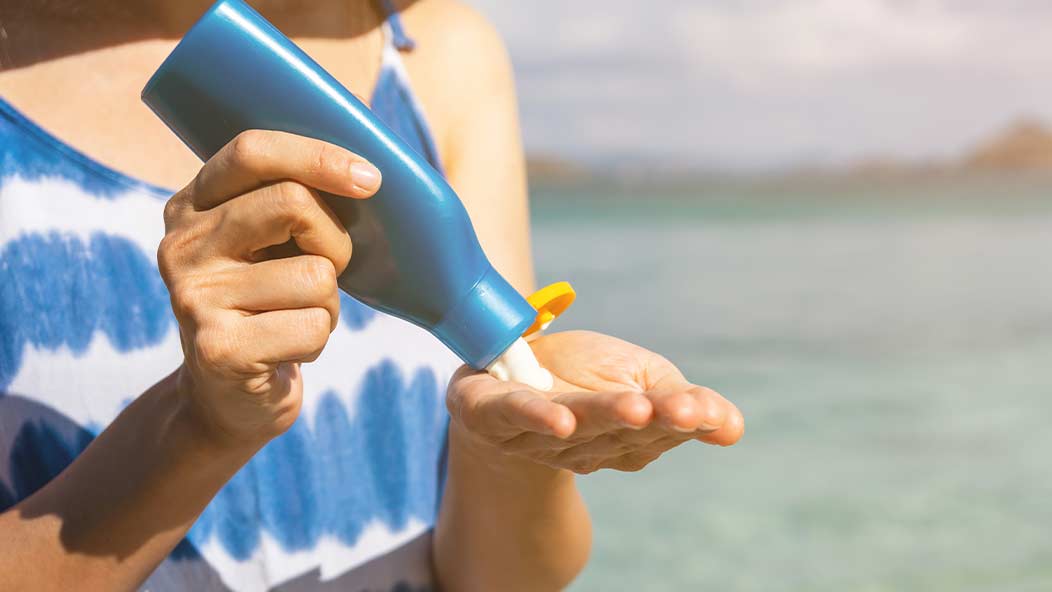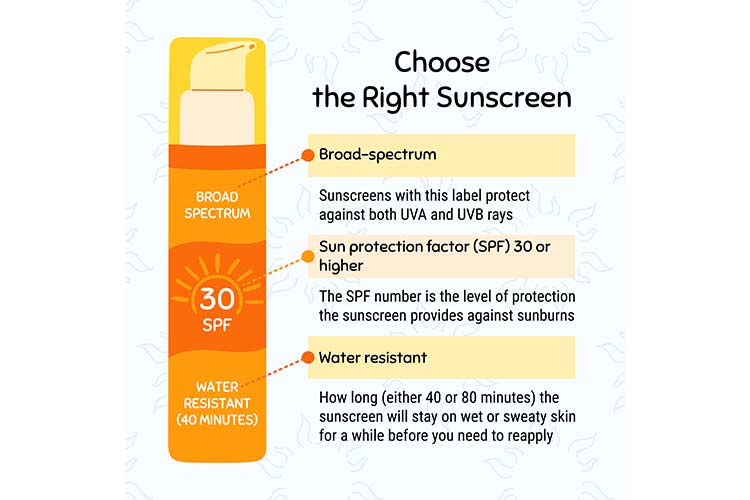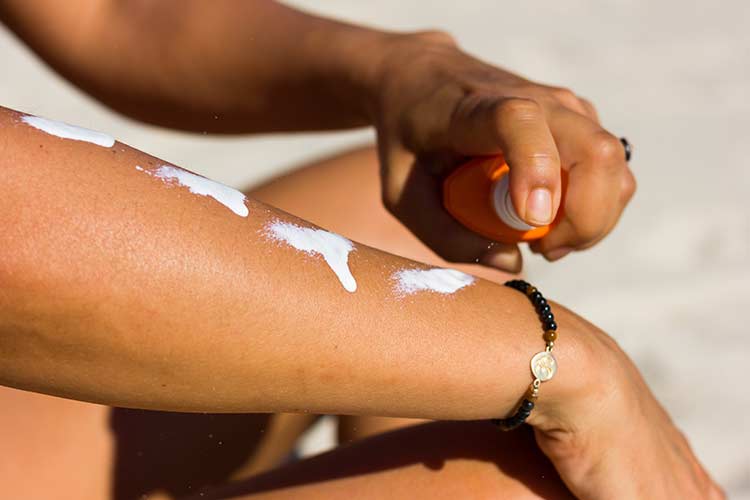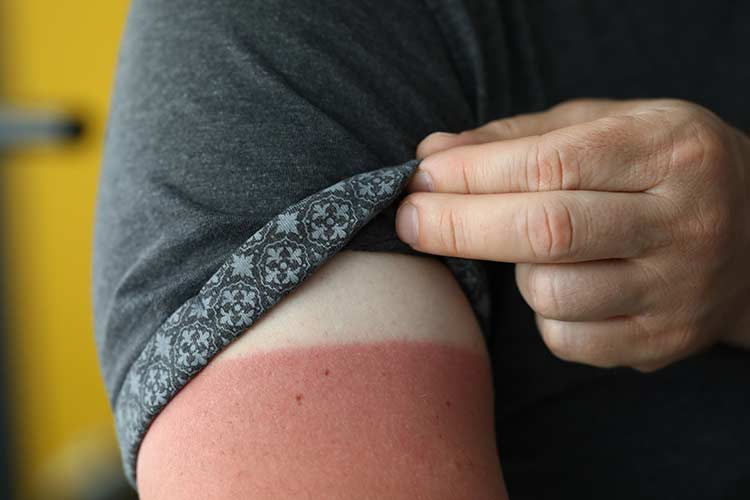Join Our eNewsletter!
Subscribe to our monthly newsletter to receive encouraging advice to help you lead a healthy lifestyle.

Summer Sunscreen Guide
By Margaret Wat, MD, PhD, FAAD
The sun sends two types of ultraviolet rays (UVA and UVB) strong enough to travel almost 93 million miles to earth. According to the Skin Cancer Foundation, up to 40% of those rays reach us even on completely cloudy days. Harmful solar radiation from sun exposure can cause irreversible skin damage and can lead to potentially deadly forms of skin cancer. Every time your skin is exposed to UV rays, changes take place in the structure of your skin cells.
Sunburn can significantly expedite the development of skin damage and increase the risk of skin cancer, but your skin doesn’t have to burn to become permanently damaged.
And if you think it has to be sunny outside for your skin to get sun damaged, think again. Even on overcast days, enough UV rays can penetrate clouds to cause sunburns.
Sunscreen Is Your Best Defense
The best defense against skin damage is to create a barrier between the sun and your skin by using a broad-spectrum sunscreen every day.
A few years ago, choosing a good sunscreen meant you simply looked for a high enough sun protection factor (SPF), which rates how well the sunscreen protects against ultraviolet B (UVB) rays, the type that can cause skin to burn.
Since then, research has demonstrated that ultraviolet A (UVA) rays also increase skin cancer risk. While they don’t cause sunburn, they penetrate deep into the skin, causing cellular damage and wrinkling, in addition to skin cancer risk. The Environmental Protection Agency (EPA) estimates that up to 90% of skin changes associated with aging are really caused by lifetime exposure to UVA rays.
Today, broad-spectrum sunscreens that help protect against both UVA and UVB rays are widely available. Daily use of a broad-spectrum, water-resistant sunscreen with an SPF of 30 or above is important. But how do you determine which one is best for you? It depends on your skin type.

Two Types of Sunscreens: Physical and Chemical
Depending on which type you use, sunscreen helps shield you from dangerous rays in one of two ways: physically or chemically.
Physical sunscreens, also known as mineral sunscreens, actually remain on the surface of your skin and reflect UV radiation. Most are formulated with zinc oxide and titanium oxide, which are the two sunscreen ingredients that are generally regarded as safe and effective by the FDA. Those containing zinc oxide are often recommended for people with skin sensitivities and for children.
If you struggle with hyperpigmentation issues (brown spots) on your skin, you should strongly consider using a physical sunscreen , as chemical sunscreens can exacerbate these issues due to the way they release heat.
In the past, you may have tried physical sunscreens and found them to be quite thick and even chalky on your skin. Fortunately, newer formulations are game-changers and come with lighter textures, along with tinted and un-tinted varieties.
Physical matte SPF 50 sunscreen is great for combination to oily skin. It’s proven to maintain a matte finish, even in humid climates like Houston.
Sheer physical SPF 50 sunscreen features an ultra-sheer, transparent fluid that combines 100% mineral filters with artemia salina, a plankton extract, to help boost skin’s natural defenses to UV and heat-induced stress. It offers broad-spectrum protection for all skin types, including sensitive.
Chemical sunscreens contain molecules that absorb UV radiation through chemical bonds. As the bonds are met with UV radiation, the components of the sunscreen slowly break down and release heat from the skin. Chemical sunscreens absorb into your skin and don’t typically leave a visible film on the skin’s surface, which makes them easy to wear on a broad range of skin tones. Most forms go on smoothly without feeling sticky or greasy.
Ultimate UV SPF 30 is a broad-spectrum protective, moisturizing chemical sunscreen with transparent zinc oxide.
To identify a chemical sunscreen, look for any of these UV filters listed on the bottle:
- Oxybenzone
- Avobenzone
- Octisalate
- Octocrylene
- Homosalate
- Octinoxate
Both chemical and physical types are available at most Kelsey Pharmacies, including varieties offered by SkinCeuticals® medical-grade skincare. Ask your Kelsey-Seybold pharmacist to help choose the sunscreen that’s right for you.
How To Properly Apply Sunscreen
No matter what type of sunscreen you choose, it can only be effective if you apply it correctly.

- Always apply sunscreen before you head outside since it takes about 15 minutes for your skin to absorb it. In fact, it’s a good idea to get into the habit of applying sunscreen before getting dressed each day.
- Adults should use about 1 ounce of sunscreen (enough to fill a shot glass) to cover the entire body.
- Apply sunscreen to all bare skin, paying particular attention to your face, neck, ears, and tops of hands and feet. These are the areas that most often sustain skin damage. Use a spray sunscreen to apply to your back. If you have thin hair or are bald, apply a small amount of sunscreen to your scalp (or wear a hat). Also apply lip balm with an SPF of at least 15 to protect your lips.
- When outdoors, reapply sunscreen to exposed skin every two hours or immediately after swimming or sweating.
Sunburn Care
Despite our best efforts to protect our skin, sunburn happens. To heal properly, it’s important to begin treating sunburn as soon as possible.

- If you notice you or your child is getting burned, try to stay out of the sun for the rest of the day.
- Take a cool bath or shower to relieve pain. When you get out, pat your skin dry, but let some water remain. Then, apply moisturizer.
- Use a moisturizer that contains aloe vera or use pure aloe vera gel. Don’t use products that end in “-caine,” such as benzocaine, that can irritate skin.
- Take aspirin or ibuprofen and apply cool compresses to affected areas to reduce swelling, redness, and discomfort.
- Drink plenty of water to prevent dehydration since sunburn draws fluid away from the body.
- Protect sunburned skin while it heals by covering it with clothing made of tightly woven (not see-through) fabric.
- If your skin is blistering, that indicates a second-degree burn. Don’t pop blisters since they form to heal and protect from infection.
- In cases of severe sunburn, see a doctor immediately.
Even a single sunburn can increase your risk of skin cancer. Every day, but especially during the summer months when UV rays are strongest, take measures to protect your body’s largest and most sensitive organ.


